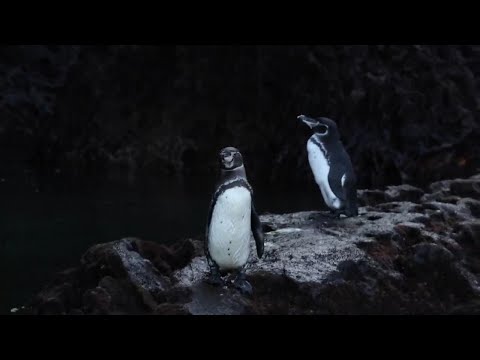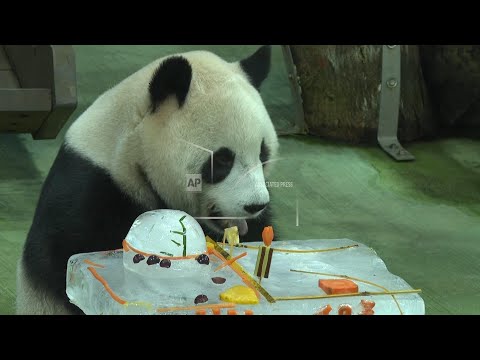(29 Jul 2024)
RESTRICTION SUMMARY:
ASSOCIATED PRESS
Galapagos Islands, Ecuador – 10 June 2024
1. Wide of divers passing through a school of fish
ASSOCIATED PRESS
Galapagos Islands, Ecuador – 9 June 2024
2. Medium of whale shark in water
ASSOCIATED PRESS
Galapagos Islands, Ecuador – 8 June 2024
3. Medium of coral
ASSOCIATED PRESS
Galapagos Islands, Ecuador – 12 June 2024
4. Wide of whale shark passing through school of fish
ASSOCIATED PRESS
Galapagos Islands, Ecuador – 8 June 2024
5. Wide of sea turtle swimming by coral
6. Wide of whale shark
ASSOCIATED PRESS
Galapagos Islands, Ecuador – 7 June 2024
7. Medium of Galápagos Penguins on rocks
8. SOUNDBITE (English) Natasha Cabezas, naturalist guide:
"But when they arrive here, they don’t find predators, they don’t find competitors, they don’t find nobody. Which was at one point a pity. But another one they develop another strategy in order to survive.”
ASSOCIATED PRESS
Galapagos Islands, Ecuador – 14 June 2024
9. Wide pan right of island
10. Detail of Ecuador flag on boat
11. Wide pan right of island
ASSOCIATED PRESS
Galapagos Islands, Ecuador – 15 June 2024
12. Medium of crab on rock near water
ASSOCIATED PRESS
Galapagos Islands, Ecuador – 7 June 2024
13. Wide of volcanic formations on island
14. SOUNDBITE (English) Natasha Cabezas, naturalist guide:
"We have a problem with cats, dogs. We used to have problems with goats, pigs. Everything we brought in was a problem, especially at the beginning."
ASSOCIATED PRESS
Galapagos Islands, Ecuador – 15 June 2024
15. Various of giant tortoise
ASSOCIATED PRESS
Mindo Valley, Ecuador – 6 June 2024
16. SOUNDBITE (English) Fernando Herrero, naturalist guide:
"I have seen changes. Animals who disappear, species who disappear, or we see a lot less and another species will have a better adaptation and now you see more.”
ASSOCIATED PRESS
Galapagos Islands, Ecuador – 14 June 2024
17. Wide of fish swimming by coral
STORYLINE:
The wondrous Galapagos Islands and its many creatures have always been sensitive to changes in ocean temperatures. But the significant warming from climate change in recent years has meant more pressure on the sea lions, marine iguanas and many other species in the remote islands hundreds of miles off the coast of Ecuador.
As if that weren’t enough, non-native species are a problem on land — that means feral cats, dogs, pigs, goats and cattle. Experts say cats and pigs compete with the Galapagos giant tortoise for food. And feral pigs can wipe out a tortoise nesting site quickly.
Warming oceans affect the food sources of many of the seagoing animals in the Galápagos. Marine iguanas — one of many species that are endemic, or unique, to the Galapagos — have a harder time finding the red and green algae they prefer. Sea turtles struggle to nest in warmer temperatures. Raising young gets harder as water warms and fewer nutrients are available.
While the Galapagos are known for a great multitude of species, their numbers aren’t unlimited.
The islands have always been sensitive to changes in ocean temperature. The archipelago itself is located where major ocean currents converge — cool from the south, warm from the north, and a cold upwelling current from the west. Then there’s El Nino, the periodic and natural Pacific Ocean warming that affects weather worldwide.
El Nino can bring food shortages for some species like marine iguanas and sea turtles, as the warmer ocean means dwindling food sources. Scientists observing the species have noted a significant decline in population numbers during El Nino events.
Find out more about AP Archive: http://www.aparchive.com/HowWeWork
Twitter: https://twitter.com/AP_Archive
Facebook: https://www.facebook.com/APArchives
Instagram: https://www.instagram.com/APNews/
You can license this story through AP Archive: http://www.aparchive.com/metadata/youtube/570176d4c9f645f6819cfaf16ab97013
Author: AP Archive
Go to Source
News post in August 3, 2024, 6:04 am.
Visit Our Sponsor’s:
News Post In – News





